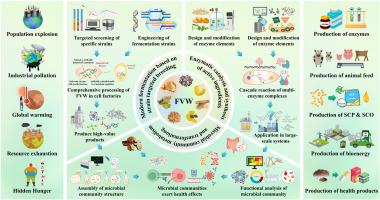Unlocking the potential of fruit and vegetable waste: Sustainable biomanufacturing strategies for synergistic nutrient recovery and high-value bioproduct synthesis
IF 15.4
1区 农林科学
Q1 FOOD SCIENCE & TECHNOLOGY
引用次数: 0
Abstract
Background
Each year, a substantial amount of fruit and vegetable waste (FVW) is discarded globally, resulting in considerable resource loss. However, FVW contains bioactive substances such as flavonoids, polyphenols and dietary fiber, which possess significant potential for development. In the context of rapid population growth and resource scarcity, innovative solutions are essential. Biomanufacturing utilizes microbial, cellular, and enzymatic metabolism to valorize FVW, enabling the recovery of bioactive compounds and the production of biobased products.
Scope and approach
Herein, we present a systematic biomanufacturing strategy for reusing FVW across three dimensions: (1) modern fermentation techniques involving strain screening and genetic engineering, (2) enzyme-based biocatalysis and synthesis via enzyme engineering, and (3) integrated microbial community metabolism and co-cultivation systems. This comprehensive strategy enables efficient conversion of FVW into bio-products with enhanced functional properties, including plant secondary metabolites, single-cell proteins (SCP), single-cell oils (SCO), biological enzyme, and biofuels, thereby maximizing the value of FVW.
Key findings and conclusions
High-throughput strain screening and cell factory engineering optimize metabolic flux, achieving SCO yields of 28 %–67 % from FVW through precision fermentation. Additionally, enzyme element design and multi-enzyme cascades enable conversion efficiencies exceeding 90 % in biotransforming FVW into bioactive macromolecules, demonstrating precise process control. Furthermore, microbial community metabolism elucidates how FVW is biotransformed into health-promoting compounds, bridging waste upcycling and human health benefits. This biomanufacturing strategy unlocks the potential of FVW in the circular economy, offering valuable insights into addressing global food security challenges and advancing the sustainable transformation of the food industry.

释放水果和蔬菜废物的潜力:协同养分回收和高价值生物产品合成的可持续生物制造战略
背景每年,全球都会丢弃大量的水果和蔬菜垃圾,造成相当大的资源损失。然而,FVW含有类黄酮、多酚和膳食纤维等生物活性物质,具有很大的开发潜力。在人口快速增长和资源稀缺的背景下,创新的解决方案至关重要。生物制造利用微生物、细胞和酶代谢使FVW增值,使生物活性化合物的回收和生物基产品的生产成为可能。在此,我们提出了一个系统的生物制造策略,在三个维度上重复利用FVW:(1)包括菌株筛选和基因工程的现代发酵技术,(2)通过酶工程的基于酶的生物催化和合成,以及(3)集成的微生物群落代谢和共同培养系统。这一综合策略能够有效地将FVW转化为具有增强功能特性的生物产品,包括植物次级代谢物、单细胞蛋白(SCP)、单细胞油(SCO)、生物酶和生物燃料,从而最大化FVW的价值。高通量菌株筛选和细胞工厂工程优化了代谢通量,通过精确发酵使FVW的SCO产量达到28% - 67%。此外,酶元件设计和多酶级联使FVW转化为生物活性大分子的转化效率超过90%,展示了精确的过程控制。此外,微生物群落代谢阐明了FVW如何被生物转化为促进健康的化合物,连接废物升级回收和人类健康益处。这一生物制造战略释放了FVW在循环经济中的潜力,为应对全球粮食安全挑战和推进食品工业的可持续转型提供了宝贵的见解。
本文章由计算机程序翻译,如有差异,请以英文原文为准。
求助全文
约1分钟内获得全文
求助全文
来源期刊

Trends in Food Science & Technology
工程技术-食品科技
CiteScore
32.50
自引率
2.60%
发文量
322
审稿时长
37 days
期刊介绍:
Trends in Food Science & Technology is a prestigious international journal that specializes in peer-reviewed articles covering the latest advancements in technology, food science, and human nutrition. It serves as a bridge between specialized primary journals and general trade magazines, providing readable and scientifically rigorous reviews and commentaries on current research developments and their potential applications in the food industry.
Unlike traditional journals, Trends in Food Science & Technology does not publish original research papers. Instead, it focuses on critical and comprehensive reviews to offer valuable insights for professionals in the field. By bringing together cutting-edge research and industry applications, this journal plays a vital role in disseminating knowledge and facilitating advancements in the food science and technology sector.
 求助内容:
求助内容: 应助结果提醒方式:
应助结果提醒方式:


